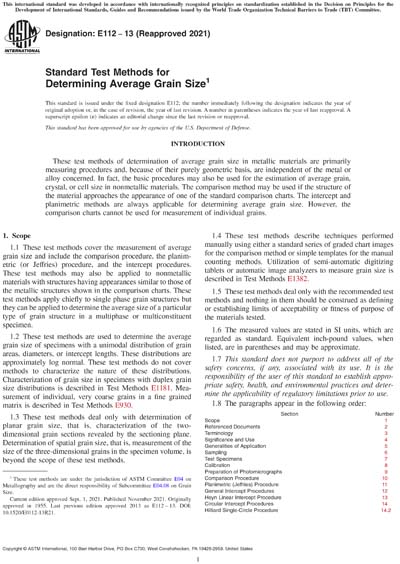Most recent
ASTM E112-13(2021)
Standard Test Methods for Determining Average Grain Size
1.1These test methods cover the measurement of average grain size and include the comparison procedure, the planimetric (or Jeffries) procedure, and the intercept procedures. These test methods may also be applied to nonmetallic materials with structures having appearances similar to those of the metallic structures shown in the comparison charts. These test methods apply chiefly to single phase grain structures but they can be applied to determine the average size of a particular type of grain structure in a multiphase or multiconstituent specimen.
1.2These test methods are used to determine the average grain size of specimens with a unimodal distribution of grain areas, diameters, or intercept lengths. These distributions are approximately log normal. These test methods do not cover methods to characterize the nature of these distributions. Characterization of grain size in specimens with duplex grain size distributions is described in Test Methods E1181. Measurement of individual, very coarse grains in a fine grained matrix is described in Test Methods E930.
1.3These test methods deal only with determination of planar grain size, that is, characterization of the two-dimensional grain sections revealed by the sectioning plane. Determination of spatial grain size, that is, measurement of the size of the three-dimensional grains in the specimen volume, is beyond the scope of these test methods.
1.4These test methods describe techniques performed manually using either a standard series of graded chart images for the comparison method or simple templates for the manual counting methods. Utilization of semi-automatic digitizing tablets or automatic image analyzers to measure grain size is described in Test Methods E1382.
1.5These test methods deal only with the recommended test methods and nothing in them should be construed as defining or establishing limits of acceptability or fitness of purpose of the materials tested.
1.6The measured values are stated in SI units, which are regarded as standard. Equivalent inch-pound values, when listed, are in parentheses and may be approximate.
1.7This standard does not purport to address all of the safety concerns, if any, associated with its use. It is the responsibility of the user of this standard to establish appropriate safety, health, and environmental practices and determine the applicability of regulatory limitations prior to use.
1.8The paragraphs appear in the following order:
1.9This international standard was developed in accordance with internationally recognized principles on standardization established in the Decision on Principles for the Development of International Standards, Guides and Recommendations issued by the World Trade Organization Technical Barriers to Trade (TBT) Committee.
Content Provider
ASTM International [astm]






